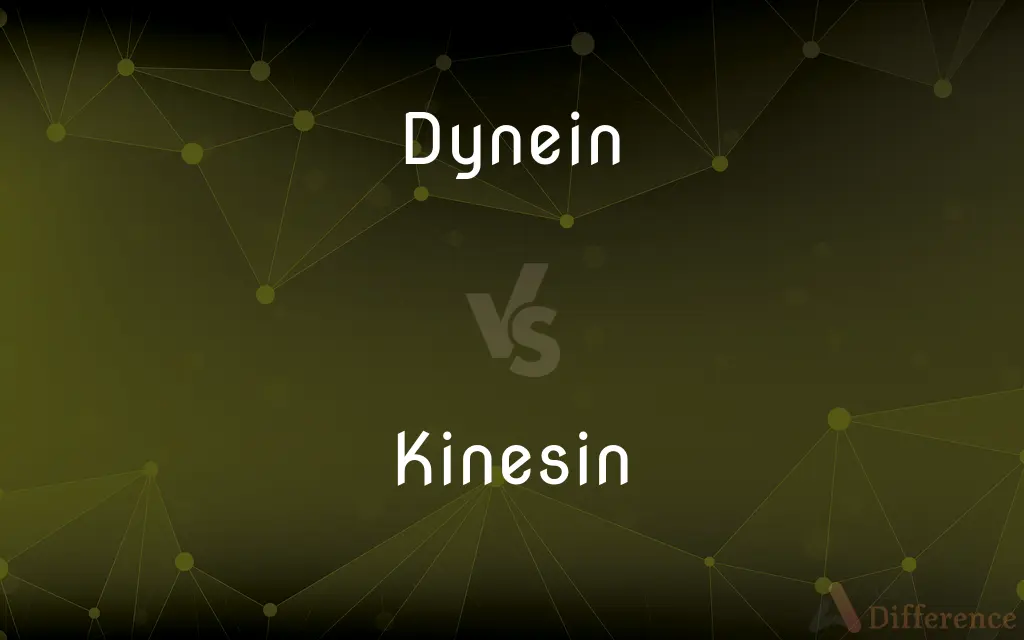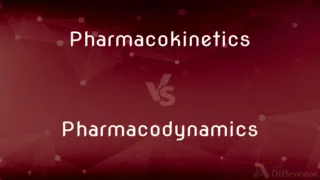Dynein vs. Kinesin — What's the Difference?
Edited by Tayyaba Rehman — By Maham Liaqat — Updated on April 15, 2024
Dynein and kinesin are both motor proteins, with dynein generally moving towards the cell's center while kinesin tends to move towards the periphery.

Difference Between Dynein and Kinesin
Table of Contents
ADVERTISEMENT
Key Differences
Dynein is primarily involved in transporting cellular cargo towards the minus end of microtubules, which is generally directed towards the cell center. On the other hand, kinesin usually carries loads towards the plus end of microtubules, typically moving towards the cell's periphery.
Both proteins are crucial for vesicle transport within cells, but dynein also plays a significant role in the positioning of organelles and mitotic spindles, whereas kinesin is additionally involved in axonal transport in neurons.
Dynein has a complex structure, often involving two heavy chains that contain motor domains, while kinesin typically functions as a dimer of two heavy chains, making it structurally simpler compared to dynein.
In terms of energy usage, both dynein and kinesin utilize ATP to fuel their movements along microtubules. However, dynein is known for its slower speed and higher force production compared to kinesin.
While both proteins contribute to cell division, dynein's role in chromosomal movement and spindle dynamics is particularly critical during mitosis, in contrast to kinesin, which primarily manages spindle fiber elongation and chromosome alignment.
ADVERTISEMENT
Comparison Chart
Directionality
Moves towards cell center
Moves towards cell periphery
Structural complexity
Typically two heavy chains with motor domains
Dimer of two heavy chains
Function
Transport of vesicles, organelle positioning, mitotic spindle dynamics
Transport of vesicles, axonal transport, chromosome alignment
Speed and force
Slower, higher force
Faster, less force
Role in cell division
Critical in chromosomal movements
Manages spindle fiber elongation
Compare with Definitions
Dynein
Involved in mitotic spindle positioning during cell division.
Dynein activity is crucial during the metaphase stage of mitosis.
Kinesin
Important for chromosome positioning during mitosis.
Kinesin aligns chromosomes during the prometaphase.
Dynein
A motor protein that moves along microtubules towards the minus end.
Dynein is essential for transporting organelles to the cell center.
Kinesin
A motor protein that primarily moves towards the plus end of microtubules.
Kinesin is vital for transporting nutrients to a cell's periphery.
Dynein
Integral to cilia and flagella movement.
Dynein arms facilitate the bending motions of cilia.
Kinesin
Involved in intracellular transport of vesicles.
Kinesin transports various vesicles within the cell.
Dynein
Dynein uses ATP to generate movement.
ATP hydrolysis triggers conformational changes in dynein.
Kinesin
Utilizes ATP to move along microtubules.
Each step of kinesin along a microtubule consumes one ATP molecule.
Dynein
Associated with retrograde transport in neurons.
Dynein carries used neurotransmitters back to the cell body.
Kinesin
Plays a key role in axonal transport in neurons.
Kinesin helps deliver neurotransmitters to synaptic terminals.
Dynein
Dynein is a family of cytoskeletal motor proteins that move along microtubules in cells. They convert the chemical energy stored in ATP to mechanical work.
Kinesin
A kinesin is a protein belonging to a class of motor proteins found in eukaryotic cells. Kinesins move along microtubule (MT) filaments, and are powered by the hydrolysis of adenosine triphosphate (ATP) (thus kinesins are ATPases, a type of enzyme).
Dynein
Any of a group of motor proteins that move along microtubules and are involved in intracellular transport of organelles and movement of cilia and flagella.
Kinesin
Any of a group of motor proteins that move along microtubules and are involved in cell division and the transport of cytoplasmic organelles.
Dynein
(enzyme) Any of a group of enzymes that hydrolyze ATP and thus provide motive power for motile structures such as microtubules.
Kinesin
(protein) Any of a class of proteins that convert chemical into mechanical energy and power the movement of vesicles and organelles along microtubules
Common Curiosities
What is the main function of dynein?
Dynein primarily transports cellular components towards the cell center and assists in organelle and spindle positioning.
How are dynein and kinesin involved in mitosis?
Dynein helps in positioning mitotic spindles and moving chromosomes, while kinesin is crucial for spindle fiber elongation and chromosome alignment.
Can dynein and kinesin be found in all cells?
Dynein and kinesin are present in most eukaryotic cells, playing key roles in intracellular transport.
What differentiates the movement of dynein from kinesin?
Dynein moves towards the minus end of microtubules (cell center), while kinesin moves towards the plus end (cell periphery).
What roles do dynein and kinesin play in neuron function?
Dynein is involved in retrograde transport, returning cellular components to the neuron's body, whereas kinesin handles anterograde transport, moving materials away from the body.
Which is faster, dynein or kinesin?
Kinesin is generally faster than dynein, which, although slower, can generate more force.
Do dynein and kinesin work independently in cells?
While dynein and kinesin can work independently, their activities are often coordinated for efficient cellular function and transport.
What happens if dynein or kinesin is dysfunctional?
Dysfunctional dynein or kinesin can lead to cellular transport issues, impacting processes like neuron function and cell division.
How are dynein and kinesin studied?
Researchers study these proteins using molecular biology, genetic techniques, and advanced imaging technologies.
What energy source do dynein and kinesin use?
Both dynein and kinesin use ATP as their energy source for movement.
What is the structural difference between dynein and kinesin?
Dynein generally has a more complex structure with two heavy chains that include motor domains, unlike kinesin's simpler dimer structure.
How does kinesin move within a cell?
Kinesin moves cargo towards the periphery of the cell by walking along microtubules towards their plus end.
Are dynein and kinesin necessary for cellular health?
Yes, both proteins are essential for maintaining cellular organization, transport, and division.
What diseases are associated with defects in dynein and kinesin?
Defects in dynein and kinesin can contribute to neurodegenerative diseases, genetic disorders, and issues with cell division.
Can dynein and kinesin function interchangeably?
Due to their directional differences and specific roles, dynein and kinesin cannot typically function interchangeably.
Share Your Discovery

Previous Comparison
Estimand vs. Estimate
Next Comparison
Pharmacokinetics vs. PharmacodynamicsAuthor Spotlight
Written by
Maham LiaqatEdited by
Tayyaba RehmanTayyaba Rehman is a distinguished writer, currently serving as a primary contributor to askdifference.com. As a researcher in semantics and etymology, Tayyaba's passion for the complexity of languages and their distinctions has found a perfect home on the platform. Tayyaba delves into the intricacies of language, distinguishing between commonly confused words and phrases, thereby providing clarity for readers worldwide.















































